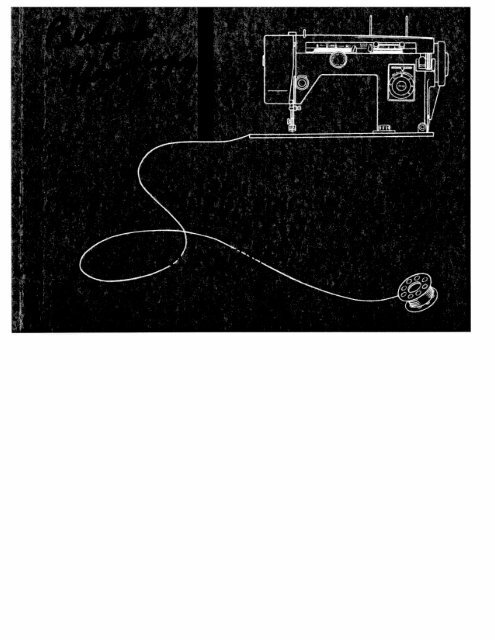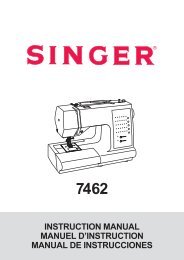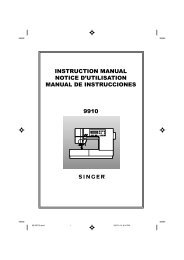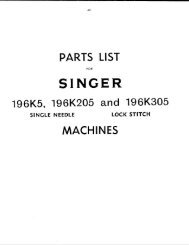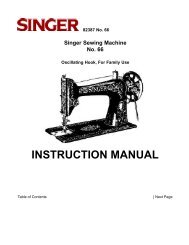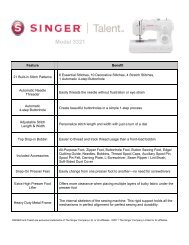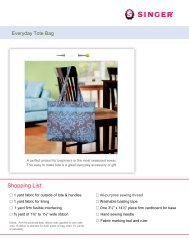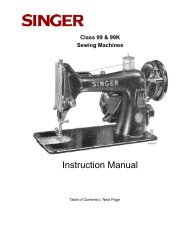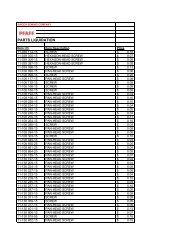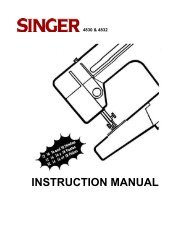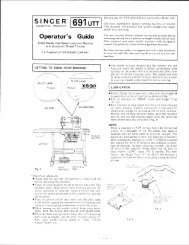Create successful ePaper yourself
Turn your PDF publications into a flip-book with our unique Google optimized e-Paper software.
You are now the owner of a new zigzag sewing machine, the most versatile typ<br />
of its kind you can possess.<br />
Beautiful decorative patterns are automatically made just by using design discs prc<br />
vided with this machine.<br />
Buttonholes, monograrnming, overcasting and creative embroidery are done with eas<br />
and speed.<br />
To aid you in obtaining the greatest performance from your new machine this book o<br />
its care and use has been written for you. Read the instructions carefully as a thoroug<br />
understanding of your machine will reward you with many hours of trouble-free, creativ<br />
sewing.<br />
Time-s&iing attachments such as rufflers, binders, edgestitchers, cording feet and sofort<br />
to complement the accessories furnished with your machine are available from the stor<br />
where you purchased your machine.<br />
WHITE CONSOLIDATED INDUSTRIES, INC<br />
CLEVELAND, OHIO 44111<br />
WHITE CONSOLICATED INDUSTRIES, LTD.<br />
111 Bermondsey Road<br />
Toronto 16 Ontario, Canada
Features and Parts 2<br />
Needle and Thread Chart<br />
Setting the Needle<br />
Winding the Bobbin<br />
Theading Bobbin Case<br />
Placing Bobbin Case in Shuttle<br />
Upper Threading<br />
Straight Stitching<br />
Changing Foot and Plate<br />
Setting the Stitch Length<br />
Stitch Length Chart<br />
Sewing in Reverse<br />
Adjusting the Tensions<br />
Adjusting Pressure and Feed<br />
General Sewing<br />
Light Weight Fabrics<br />
Darning and Monogramming<br />
Preparing to Sew<br />
Removing the Work<br />
Creative Embroidery<br />
Satin Stitch<br />
Adjusting Stitch Width<br />
Embroidery Patterns<br />
Samples of Embroidery<br />
To Make Mechanical Designs<br />
Embroidery With a Hoop<br />
Darning<br />
INDEX<br />
Page<br />
34 5<br />
6<br />
6<br />
7<br />
8<br />
9<br />
10<br />
10<br />
11<br />
11<br />
11<br />
11<br />
12<br />
12<br />
13<br />
13<br />
13<br />
14<br />
14<br />
14<br />
15<br />
15<br />
15<br />
16<br />
17<br />
17<br />
Pag<br />
Making Buttonholes 18<br />
Sewing on Buttons 19<br />
How to Use Accessories 20 21 22<br />
Narrow Hemmer 20<br />
Lace Trimmed Hem 20<br />
Lace Edge 21<br />
French Seam 21<br />
Flat Felled Seam 21<br />
Hand Rolled Effect 21<br />
Quilting Guide 21<br />
Seam Gauge 22<br />
Care and Maintenance 22<br />
Oiling 23<br />
Cleaning and Oiling Shuttle 24<br />
How to Change the Motor Belt 25<br />
Accessories 26<br />
Trouble Charts 27 28 -29<br />
Attachments 31 32 33 34 35-36<br />
Attachment Foot 32<br />
Edgestitcher 32<br />
Ruffler 35<br />
Binder 33<br />
Hemmers 34<br />
Darning Spring 34<br />
Cording & Zipper Foot 36<br />
Sewing on Zipper 36
2<br />
Fig. 1
FEATURES AND PARTS<br />
Front View)<br />
1. Spool Pins 13. Presser Foot<br />
2. Stitch Width Lever ,<br />
14.<br />
Needle Clamp and Screw<br />
3. Zigzag Stop Knobs 15. Attachment and Foot Thumb Screw<br />
4. Hand Wheel 16. Needle Bar Thread Guide<br />
5. Wheel Clutch 17. Thread Guides<br />
6. Bobbin Winder 18. Tension Regulator<br />
7. Stitch Length Dial 19. Light Switch<br />
8. Reverse Push Button 20. Take-up Lever<br />
9. Bobbin Winding Tension 21. Pressure Release Darner<br />
10. Drop Feed Knob 22. Arm Thread Guide<br />
11. Cover Plate 23. Button hole Change Lever 7/<br />
12. Needle Plate-Seam Guide 24. Pattern Selector Dial
4<br />
25. Thread Cutter<br />
26. Presser Bar Lifter<br />
.<br />
FEATURES AND PARTS<br />
Back View)<br />
— 26<br />
-25<br />
27. Feed<br />
28. Hinge Holes<br />
Fig. 2<br />
for cabinet or portable case<br />
29. Hinge Clamp Sc<br />
30. Motor Cover<br />
27<br />
28<br />
29
NEEDLE - THREAD - FABRIC - STITCHING<br />
GUIDE<br />
Machine<br />
Silk<br />
Fabric<br />
Needle<br />
No.<br />
Stitches<br />
Per Inch<br />
Cotton<br />
Thread<br />
Mercerized<br />
Thread<br />
or<br />
Nylon<br />
Extremely heavy 6 10<br />
tarpaulin, sacking, 4 to to Heavy Duty<br />
canvas, duck, etc. 8 30<br />
Heavy upholstery 8 30<br />
fabric, thicking, 3 to to Heavy Duty<br />
denim, leatherette 10 40<br />
Medium heavy drapery 10 40<br />
fabric, velveteen, 2 to to Heavy Duty<br />
suiting, felt, terry, etc. 12 60<br />
Medium broadcloth,<br />
percale, gingham, linen,<br />
chintz, taffeta, sheer<br />
wool, shantung, etc.<br />
12 60<br />
1 to to 50 A<br />
14 80<br />
Sheer voile, lawn, 14 80<br />
dimity, crepe, 0 to to 50 A<br />
handkerchief linen, 16 100<br />
plastic film, etc. Plastic film<br />
8 to 10<br />
Very sheer chiffon, 16 100<br />
batiste, lace, orgady, 00 to to 50 A<br />
ninon, net, marquisette, etc. 20 150
6<br />
Fig. 3<br />
SETTING THE NEEDLE<br />
See Fig. 3. Raise the needle bar A to its<br />
highest point, turning wheel toward you by hand.<br />
Then loosen the needle clamp screw B and the<br />
needle can be inserted into clamp C. Place needle<br />
flat side to ricrht in the needle clamp and push<br />
it up-ward as tar as it will go into the needle<br />
clamp hole, tightening the needle clamp screw<br />
securely with a screw driver.<br />
After changing needle make one completed re<br />
volution of balance wheel by hand to be sure the<br />
needle is in the correct position.<br />
SIDE<br />
______<br />
HOW TO WIND THE BOBBIN<br />
Disengage the hand wheel 4, Fig. 4 from the stitching mechanism<br />
by turning the clutch 5, Fig. 4. toward you or counterclockwise.<br />
Place a spool of thread on one of the spool pins, lead<br />
thread through the upper thread guides on the arm, and down<br />
.j —<br />
I,<br />
through the tension disc B, Fig. 5 at<br />
the base of the machine. Run end of<br />
thread through the hole in the bobbin<br />
edge and place bobbin C on spindle of<br />
bobbin winder E, fitting the notch on<br />
bobbin over small pin on spindle. Push<br />
bobbin winder pulley against hand wheel.<br />
‘<br />
-.<br />
‘<br />
Hold thread end<br />
chine slowly.<br />
loosely and start ma-<br />
Fig. 5<br />
Bobbin will stop winding when it is filled. Turn clutch away<br />
you or clockwise until sewing machanism is again engaged so that nec<br />
moves when you turn the hand wheel.<br />
Break off loose thread end used to start the winding.<br />
Fig.<br />
l!II
THREADING THE<br />
BOBBIN CASE<br />
Step 1 illustrated in Fig. 6<br />
Hold bobbin case between thumb<br />
and forefinger of left hand, so that Fig. 6<br />
the slot in the edge of the bobbin<br />
case is on top.<br />
Take the bobbin between thumb<br />
and forefinger of right hand so that<br />
the thread on top leads from leftto<br />
right.<br />
Step. 2.<br />
Insert bobbin into bobbin case,<br />
pull the thread into the slot of the<br />
bobbin case as shown in Fig. 7, and<br />
draw it under the tension spring and<br />
into the fork-shaped opening of the<br />
spring as shown in Fig. 8.<br />
Fig. 7<br />
Fig. 8<br />
.7
8<br />
PLACING BOBBIN CASE IN SHUTTLE<br />
Open hinged cover plate left of the needle.<br />
See Fig. 1 Hold the bobbin case latch, D , Fig.<br />
9, between the thumb and forefinger of the left<br />
hand, with at least three inches of thread running<br />
from the top of the bobbin case to the right, Insert<br />
and center the bobbin case on the stud of the shuttle<br />
body, C . Be sure<br />
the bobbin case<br />
finger, E , will en<br />
ter the shuttle race<br />
notch, A. Press<br />
the bobbin case B<br />
into the shuttle as<br />
far as possilbe until<br />
latch catches on the<br />
center<br />
shuttle.<br />
post of the<br />
Fig. 9 THEN release<br />
the bobbin case latch, D. Press bobbin case<br />
again after latch has been released to make sure<br />
the bobbin case is locked securely in place.<br />
the cover plate.<br />
Close<br />
Fig 10<br />
©<br />
©.<br />
\
UPPER THREADING<br />
Fig. 10<br />
1 Turn hand wheel toward you to raise take-up<br />
lever to its highest position<br />
2 Place spool of thread on upper spool pin<br />
3 Lead thread through arm thread guide A<br />
4 Down and around tension discs B from right to<br />
left<br />
5 Into the check spring C over discs<br />
6 Then down under thread under bar D See in<br />
sert, Fig. 10<br />
7 Up into take-up lever E from right to left Fig. 11<br />
8 Down into thread guide F on face plate<br />
9 Through the needle bar thread guide G<br />
10 And into needle from left to right. Full three or four inches of thread through needle.<br />
Hold the end of upper thread loosely and turn hand wheel toward you until the needle goes<br />
ill the way down and comes back up. A lcop Fig. 11 will be formed over the lower thread<br />
.vhich then can be pulled out straight. Place both thread ends under the slot of the presser foot<br />
md draw toward the back of the machine, leaving both threads three cr four inches long.<br />
1’
10<br />
STRAIGHT STITCHING<br />
For straight stitching on fine fabric or very soft ma<br />
terial, you may want to use the straight stitch presser<br />
foot and the straight stitch needle plate which are includ<br />
ed in your accessory box. Both have narrow needle slots.<br />
Changing the Foot and Plate. To change presser<br />
foot 13, Fig. 1 loosen thumb screw 15, Fig. 1 and<br />
____ _____ _<br />
remove zigzag foot. Replace with hinged narrow foot 4 ‘<br />
and tighten screw securely.<br />
To change needle plate 12, Fig. 1 remove it with Fig. 12-A<br />
cover plate from machine. Turn assembly wrong sideup.<br />
Hold needle plate in left hand and cover plate in right.<br />
Fig. 12-A’<br />
Slip upper pin on cover plate out of groove on needle<br />
plate, and pull upper portion of cover plate away. Then<br />
lower pin can be separated from groove as the tongue on<br />
cover plate slips out of the spring latch on needle plate.<br />
To attach cover plate to straight stitch plate, again<br />
hold assembly wrong side UD. Holding cover plate in<br />
right hand at a slight upward angle, slide lower pin into<br />
groove, then lift cover plate to insert tongue into opening<br />
of spring latch. Upper pin will then slide easily into<br />
groove.<br />
Put plates on machine and fasten securely with needle<br />
plate screws.<br />
Be sure to set the stitch width at 0 or the needle<br />
will break in striking the foot or plate. Adjust stoppers Fib. 12-B<br />
3 to hold zigzag lever 2 in 0 position.<br />
8
2<br />
I<br />
SETTING THE STITCH LENGTH<br />
The length of the stitch is regulated by knob 7 shown in Fig. 12-B. Near 0 is the shortest<br />
id 5 is the longest. Turn the knob to the left to lengthen and to the right to shorten the stitch.<br />
STITCH LENGTH CHART Approximate<br />
Figure on indicator 0 1 2 3 4 5<br />
Number of stitches per inch No feeding 55 25 13 8 6<br />
SEWING IN REVERSE<br />
When you wish to sew in reverse to tie the thread at the beginning or the end of a seam,<br />
ress in the reverse button 8 Fig. 12-B as far as it will go. The machine will sew backward as<br />
ng as the button is held in. Only 4 or 5 stitches are needed to tie a seam securely.<br />
ADJUSTING THE TENSIONS<br />
Always adjust the upper tension with the presser foot<br />
own, as the tension is automatically released when it is raised.<br />
I o increase the tension on the upper thread, turn dial Fig.<br />
4 13 to the right, or clockwise. To decrease, turn to the left.<br />
Che higher the number on the dial the tighter the tension.<br />
3efore adjusting lower tension be sure that the machine is<br />
hreaded properly.<br />
When it is necessary to change the bobbin tension, turn<br />
3mall screw Fig. 14 on side of the bobbin case clockwise<br />
to tighten, counter-clockwise to loosen.<br />
Fig. 13
12<br />
When the upper and under tentions are properly ba<br />
lanced, a perfect stitch will be formed with both threads<br />
interlccking in fabric. Fig. 15<br />
When the upper tension is too tight, the lower thread<br />
is pulled up over the upper thread which is lying flat<br />
on the fabric. Fig. 16<br />
When the upper tension is too loose the upper thread<br />
forms loops over the lower thread lying flat on the fabric.<br />
Fig. 17<br />
ADJUSTING PRESSURE<br />
AND FEEDING OF FABRIC<br />
GENERAL SEWING<br />
Usually for straight sewing and zigzag stitching, the pressure bar cap or darner release<br />
Fig. 18, is at its lowest position and the drop feed knob is turned high pcsition, Fig. 19.<br />
Fig. 15<br />
Fig. 16<br />
Fig. 17<br />
____ ____ ____<br />
_______<br />
21<br />
Fig. 14<br />
Fig. 18 Fig. 19<br />
•1
SEWING THIN OR LIGHT WEIGHT FABRIC<br />
When lighter pressure is required to sew satisfactorily on thin<br />
ilk or filmy material, the pressure cap should b9 about half-way<br />
own. Release all the way by pressing the snap lock, A. Fig. 20,<br />
ad then press cap B down again to half-way spot. Lower the<br />
ed slightly by turning the red arrow on the knob to “LOW”<br />
osition.<br />
DARNING AND MONOGRAMMING. In order to move the<br />
bric freely in any direction for darning, mending and certain<br />
14<br />
REMOVING THE WORK<br />
Be sure to stop the machine when the thread take-up lever<br />
and needle bar are located at the highest position. Now raise<br />
the presser foot and draw the fabric back and to the left, Fig.<br />
21-A and B, and pass the threads over the thread cutter.<br />
Pull down slightly, holding thread in both hands, so as not<br />
to bend the needle.<br />
place.<br />
Leave the ends of thread under the presser foot.<br />
CREATIVE EMBROIDERY<br />
Be sure zigzag presser foot and zigzag needle plate are in<br />
The satin stitch, Fig. 22,<br />
which is really just a very short<br />
zigzag stitch and the basis for<br />
Fig. 22<br />
most embroidery, is obtained by setting the stitch length as<br />
near 0 as possible without stopping the feeeding action.<br />
The width may be set anywhere from just past 0 to the<br />
widest, 4.<br />
Fig. 21-A<br />
Fig. 21-B
‘1usting the stitch width<br />
To stitch continuously at one width of zigzag stitching set lock 3 Fig. 12B to hold zigza<br />
v r at width chosen. Should you wish to move freely between any two widths, in doing fre<br />
md embroidery, move zigzag width lever to the right and set left hand stop at desired width<br />
move lever to the left and set the right hand stop. To move stops, press with thumb an<br />
,Itove to selected pDsition.<br />
iinbroidery Patterns<br />
With the machine set for a short stitch length, different designs can be made by swinging th<br />
htch width or zigzag lever back and forth between 0 and 4 or any other combination of widths<br />
Ty setting the locks at 1 and 4, 2 and 3, etc. Set a rhythm for yourself and then proceed<br />
After a while you will become quite skillful, varying your designs by the speed of the machine<br />
;titch length and width end the manipulation of the lever.<br />
md 4.<br />
SAMPLES OF CREATIVE EMBROIDERY<br />
You can sew the patterns A, B, C and D when you set the button hole<br />
I at M position. When you set the lever at red point position beside the<br />
hole, you get E, F, G and H patterns by operating stitch width lever back<br />
A & E Sew a few stitches at 4 width, then quickly<br />
move lever back to 0 for a short period.<br />
Count, if necessary, to establish a rhythm.<br />
ti & F Set stops at 2 and 4, then move lever slowly<br />
between settings, operating machine rather<br />
fast.<br />
& G Set stops at 1 and 4. Gradually move lever<br />
from 1 to 4, then snap it back quickly to 1.<br />
I) & H Set both stops at 4, stitch length at 1’/. Do<br />
a few zigzag stitches, drop feed for 3 or 4<br />
stitches then raise it again. By operating the<br />
drop feed knob rhythmically it is not neces<br />
sary to count stitches.<br />
change lever 23 Fig<br />
first step for button<br />
and forth between C<br />
DC B A E F G<br />
Fig. 23 Fig. 24<br />
I
0,<br />
02 0CD<br />
CD P)<br />
—-<<br />
Dr<br />
0<br />
0 0_ CD<br />
CD 0 CD<br />
G) X1 C r--Oj 0<br />
0 CD -“L2 CD cv<br />
-ww yr H I<br />
H Z<br />
I<br />
0kCD<<br />
Ix1<br />
— — 00-C)-<br />
CD<br />
jj<br />
—<br />
0HCD-- Lu<br />
0<br />
Wk vt’ ci<br />
PCD<br />
I!H !<br />
--— z<br />
0<br />
0<br />
°CD 0Q
EMBROIDERING WITH A HOOP<br />
It is easy to follow a stamped design or to work<br />
e hand when embroidering or monograrnming. See<br />
ig. 27<br />
Release the pressure from the foot by pressing<br />
own the snap look on the automatic darner. Turn<br />
rop feed knob to DOWN position See. Fig. 19<br />
Stretch the fabric in an embroidery hoop, and<br />
place under the needle after removing the presser<br />
foot. Set the stitch width at the size you prefer and<br />
lower the presser bar lifter. Then operate the machine at a rather high speed while moving the<br />
hoop slowly with both hands. Work carefully and be sure to keep fingers out of the path of the<br />
needle.<br />
DARNING<br />
Release pressure from foot and drop feed as directed above.<br />
Place fabric to be mended under foot, and stitch around hole, moving the fabric firmly and<br />
lowly in any direction. Be sure to hold the fabric taut or skipped stitches will be encountered<br />
Fig.<br />
1
18<br />
MAKING BUTTONHOLES<br />
Mark the beginning and end of the buttonhole on fabric with a<br />
basting line or tailer’s chalk. Make one on scrap fabric following<br />
directions below to be sure machine adjustments are correct.<br />
1. Replace presser foot with buttonhole foot which provides maxi<br />
mum visibility and allows closely spaced stitches to feed evenly.<br />
Fig. 28<br />
2. Reset the mechanic design selector dial 24 Fig. 1 at M position.<br />
3. Set the stitch length dial 7 Fig. 1 as near to 0 as possible with<br />
out stopping the feeding action.<br />
4. Lock the stitch width lever 2 Fig. 1 setting step 2 Fig. 1.<br />
5. Set the button hole change lever 23 Fig. 1 to ] position.<br />
Lower needle carefully into the mark on fabric indi<br />
cating the beginning of buttonhole. Stitch to the<br />
mark for the end of buttonhole, step 1, Fig. 29,<br />
stopping machine with needle in fabric at right side<br />
of stitching.<br />
6. Set the buttonhole change lever at position, step<br />
2. And sew 5 or 6 stitchcs.<br />
7. Set the buttonhole change lever for left-hand side<br />
of buttonhole, at position. This will mechanically<br />
set the machine to sew in reverse. Sew left-hand<br />
U’U;L<br />
8. Set the buttonhole change lever at position, step<br />
9. Return stitch width lever to 0 and take two or three stitches to fasten bar tack threads E<br />
prevent ravelling.<br />
Fig. 29<br />
Fig. 28<br />
side of buttonhole. Step 3.<br />
4. Sew 5 or 6 stitches.<br />
10. Cut the buttonhole opening with seam ripper, being careful not to cut the stitching.
If you set the stitch width lever near to 0 position, you will get<br />
wide cutting space between left-hand and right-hand sides, the<br />
jher the number the less cutting space.<br />
A wide cutting space can be use as an opening for a belt or<br />
bbon.<br />
If you plan to make buttonholes on sheer or soft material, place<br />
1atan or paper, under fabric which can be turn away after stitching,<br />
is always wise to make several buttonholes on scraps of fabric be—<br />
e working on the garment.<br />
SEWING ON BUTTONS<br />
Remove hinged presser foot and attach button sewing foot. See<br />
30-A, A and C<br />
Turn drop feed knob to “DOWN”<br />
Move zigzag width lever to “0” position or to the extreme left.<br />
Place the button so that its left hole comes directly under the<br />
needle, then gently lower the presser foot. Move the zigzag<br />
width lever to the right until the needle comes exactly over the<br />
right hole of the button and set left stop. Turn the balance wheel<br />
slowly by hand to be sure the needle clears both holes of the<br />
button. Correct width if necessary.<br />
When needle goes into the center of each hole, run the machine<br />
at medium speed, making five or six stitches, stopping with the<br />
needle in the left hole.<br />
To lock the zigzag stitch and prevent ravelling,<br />
set the stitch width at 0, and take a few stitches<br />
in the same hole. f you wish you may place a<br />
rounded toothpick over the button, between the<br />
two holes, and sew button to fabric in regular way.<br />
Remove the toothpick and wind thread under<br />
button, forming a shank. Fasten. Apply the above<br />
method to sew on buttons with four holes, hooks<br />
and snaps, etc.<br />
Fig 30-C<br />
Fig. 30-A<br />
Fig. 30-B<br />
19<br />
a
20<br />
If a four hole button is to be sewn, follow the<br />
same procedure above for the two hole button. Now<br />
lift presser foot slightly and move fabric to permit<br />
stitching the remaining two holes. Hooks, snaps, etc.,<br />
are sewn to the fabric with the same procedure as<br />
for sewing two hole buttons.<br />
HOW TO USE ACCESSORIES<br />
NARROW HEMMER With the needle at its<br />
highest position, replace regular presser foot with<br />
narrow hemmer Fig. 31 .<br />
For<br />
a plain narrow hem,<br />
make a 1 8 inch double fold for about two inches<br />
along edge of fabric. Hold each end of the two<br />
inches fold, slip underneath hemmer. Bring fold up<br />
into the scroll of hemmer, draw forward to end and<br />
fasten with point of needle. Lower presser bar lifter.<br />
Gently pull ends of thread as you start stitching.<br />
Guide material slightly to right, and it will automatic<br />
ally take a double turn through scroll.<br />
LACE TRIMMED HEM To sew a narrow hem<br />
and attach lace in one stitching, insert lace in the<br />
slot next to needle Fig. 32 .<br />
Sew<br />
hem as above,<br />
guiding lace under needle and hem into scroll.<br />
(<br />
Fig. 31<br />
Fig. 32<br />
.:
Fig. 33<br />
Fig. 34<br />
LACE EDGE WITH INVISIBLE STITCHING Hold lace 1. 8 inch from raw edge on right side<br />
f fabric. Insert both in scroll as for plain narrow hem Fig. 33. Let hem roll over and sew<br />
n lace. Press lace out flat along edge with hem turned up. It is possible to have a little full<br />
ess in lace by feeding it freely under scroll.<br />
FRENCH SEAM With right side together, place top piece of material 1 8 inch inside egde<br />
I lower piece. Insert in hemmer scroll, allowing hem to roll over and sew in top fabric, making<br />
nch seam.<br />
FLAT FELLED SEAM Open out French seam and insert rolled edge in scroll of hemmer.<br />
Igestitch to lay seam flat.<br />
HAND ROLLED EFFECT Use a narrow zigzag stitch, just wide enough to catch both edges<br />
I the narrow, rolled hem.<br />
QUILTING GUIDE This guide for making parallel rows of stitching is attached by placing<br />
e pronged holder between the presser foot and the presser foot thumb screw ) Fig. 34 Adjust<br />
e curved bar to press lightly on the fabric. By letting the guide ride on the first stitching line,<br />
lccessive rows will be an equal distance apart. When the bar is attached so that the curved part<br />
to the right of the needile, it may also serve as a seam width guide.
22<br />
SEAM GAUGE OR CLOTH GUIDE Use the<br />
seam gauge as a guide for straight seams and even<br />
rows of top stitching along edges of fabric. Fasten<br />
gauge with accompanying screw in threaded hole in<br />
bed of machine Fig. 35 .<br />
desired.<br />
Adiust<br />
to seam width<br />
CARE AND MAINTENANCE OF’<br />
YOUR MACHINE<br />
HOW TO OIL YOUR MACHINE<br />
Your machine should be oiled occasionally to<br />
keep it operating smoothly how often depends on the<br />
amount of sewing you do.<br />
Before oiling the upper part of the sewing unit<br />
at points indicated by arrows in Fig. 36, turn hand<br />
wheel toward you until the take-up lever is at its<br />
lowest point. Remove top cover by loosening two<br />
screws on cover.<br />
.<br />
%L<br />
Fig. 35<br />
Fig. 36<br />
‘.<br />
:1
Fig. 37<br />
Avoid over-oiling only a drop is needed at each point.<br />
To oil parts under the bed of the machine, tip the unit back on its hinges and apply a drop<br />
oil at each point indicated in Fig. 37.<br />
To oil moving parts inside the face plate, which only rarely require oiling, open plate. Oil<br />
;pots indicated in Fig. 38.<br />
Fig. 38<br />
1<br />
23
24<br />
CLEANING AND OILING THE SHUTTLE<br />
The stitch forming mechanism occasionally becomes clogged with loose threads and<br />
This will interfere with the efficient operation of the machine. Cleaning and removal of th<br />
will safeguard the performance. To remove the shuttle assembly, proceed as follows.<br />
1. Turn the balance wheel until the needle reaches its highest position. Tilt head back<br />
hinges.<br />
2. Remove bobbin case A , Fig. 40.<br />
3. Turn the two shuttle race cover clamps B outward and remove the shuttle race cove:<br />
and shuttle body D<br />
4. Clean the shuttle race, the shuttle, and shuttle race cover by removing all threads, lin<br />
5. Apply a drop of oil with finger tip to outer edge of shuttle. When the cleaning has<br />
completed, proceed as follows to replace the shuttle assembly:<br />
1 Turn the balance wheel until the needle reaches its highest position.<br />
2 Place shuttle body, D , against shuttle driver and adjust into position.<br />
%:1<br />
(<br />
Fig. 39 Fig. 40<br />
I)
3 Replace shuttle race cover, C ,<br />
fitting<br />
pin at lower edge into<br />
notch, and lock into position with shuttle race cover clamps,<br />
B ,<br />
making<br />
certain the clamps have been snapped securely in<br />
to position.<br />
4 Put bobbin into the bobbin case.<br />
3 Put the bobbin case into the shuttle race, fitting tongue into<br />
notch E of race cover.<br />
HOW TO CHANGE THE MOTOR BELT<br />
If it should become necessary to replace the motor belt on your<br />
ichine, proceed as follows:<br />
‘F<br />
A<br />
______<br />
‘I’ll’<br />
..IIl1Ii<br />
piW<br />
Fig. 41<br />
1<br />
1. Remove screws A Fig. 41<br />
2. Remove rear cover.<br />
3. Remove clutch nut B in center of<br />
hand wheel Fig. 41 by taking<br />
out small screw C. Turn nut<br />
counter-clockwise by holding the<br />
take-up lever until it can be lifted<br />
off.<br />
4. Before moving hand wheel, note<br />
position of lips on washer D Fig.<br />
42) as it will fall off when<br />
changing the belt.<br />
5. Slide old belt over motor pulley<br />
E Fig. 42<br />
6. Pull hand wheel away from ma<br />
chine just far enough to allow<br />
the belt to slip over wheel.<br />
7. Put new belt in grooved section<br />
of hand wheel and then over<br />
motor pulley.<br />
8. Replace washer D in original<br />
position.<br />
Fig. 42<br />
Fig. 43
26<br />
9. Replace clutch nut and screw C. After doing this, turn clutch toward you to disengage sew<br />
ing mechanism. If the needle still moves up and down as you turn the hand wheel, again<br />
remove the clutch nut, give washer D a half turn and replace the nut,<br />
10. Replace rear cover.<br />
2<br />
:.::<br />
-J<br />
2<br />
1 Plastic Oiler<br />
2 Large Screw Driver<br />
3 Small Screw Driver<br />
4 Package of Needles<br />
5 Cloth Guiie<br />
6 Buttonhole Foot<br />
7 Small Hemmer Foot<br />
8 Quilter Guide<br />
9 Thumb Screw<br />
ACCESSORIES<br />
10 Bobbins :3:<br />
11 Felt Washers<br />
for spool pins<br />
12 Presser Foot for<br />
Straight Sewing<br />
13 Needle Plate for<br />
Straight Sewing<br />
14 Button Sewing Foot<br />
15 Buttonhole Cutter
TROUBLE CHART<br />
Trouble Probable cause Correction<br />
If machines<br />
bind<br />
Thrsad or lintlin rase way 1.- With take-up lever in highest posision,<br />
tilt head back on hinges and remove<br />
bobbin case.<br />
NOT C H<br />
PACE<br />
2.- Turn clamps downward and remove race<br />
cover.<br />
3.- Remove hook.<br />
4.- Clean thread and lint from all parts, in<br />
cluding race.<br />
5.- Run a drop of oil along rim of hook.<br />
6.- Replace hook, then race cover. Snap<br />
clamps into place.<br />
7.- Grasp threaded bobbin case by latch and<br />
replace, fitting tongue into notch of face<br />
cover.<br />
27
28<br />
Trouble Probable Cause Correction<br />
Skipping<br />
stitches<br />
Bent needle Discard and replace.<br />
Needle placed incorrectly<br />
in clamp.<br />
Too fine a needle for thread<br />
being used.<br />
See instruction Page 6.<br />
See needle and thread chart, page 5.<br />
Upper thread tension too<br />
loose.<br />
Tighten upper tension.<br />
Irregular<br />
stitches Improper threading. See threading instruction, page 9.<br />
Uneven<br />
stitches<br />
Bobbin not wound even. Rewind bobbin.<br />
Pulling or holding material. Avoid pulling or holding material just guide it.<br />
Not enough tension on<br />
upper thread.<br />
IncreasD tension.<br />
Poor quality thread. Try different thread.<br />
Needle too fine for thread<br />
being used.<br />
See needle and thread chart, page 5.
Trouble<br />
Upper thread<br />
breaking<br />
Material<br />
puckering<br />
Probable cause<br />
Improperly threaded.<br />
Too much tension.<br />
Starting with take up in<br />
incorrect position.<br />
Improper setting of needle.<br />
Eye of needle too sharp.<br />
Bent or blunt needle.<br />
Tension too tight.<br />
Dull needle.<br />
Stitch length too long.<br />
Correction<br />
Refer to threading instructions see page 9<br />
and rethread machine.<br />
Loosen tension on upper thread by turning<br />
thread tension knob to lower number.<br />
Always start sewing with take up lever in<br />
highest position.<br />
Refer to needle setting instructions see page<br />
6.<br />
Try a new needle.<br />
Discard all blunt or bent needles and replace<br />
with new one.<br />
See tensions adjustment page 11.<br />
Change needle.<br />
Reduce stitch length.<br />
29
Your sewing machine comes equipped with the basic set of acces<br />
sories described earlier in this Eook.<br />
The following pages illustrate additional time saving attachments<br />
that have been designed syecifically for your machine. They are<br />
available at modest cost from your dealer. If your dealer cannot<br />
supply you with these items, ask him to order them for you by part<br />
number. Then you will be assured of receiving the genuine part<br />
designed for best performance with your machine.<br />
If a sewing machine dealer is not available mail your inquiry<br />
directly to:<br />
In Canada:<br />
WHITE CONSOLIDATED INDUSTRIES, INC.<br />
CLEVELAND, OHIO 44111<br />
WHITE CONSOLIDATED INDUSTRIES, LTD.<br />
111 BERMONDSEY ROAD<br />
TORONTO 16, ONTARIO, CANADA
SOME OF THE ATTACHMENTS AVAILABLE FOR YOUR MACHINE<br />
PARTS 14O3<br />
Ruffler<br />
PART :82528<br />
Attachment Foot<br />
PART 499O<br />
Darning Spring<br />
PART 74159<br />
Binder<br />
Hemmers<br />
S<br />
PART 763a3 PAR’I’ 76552 PART 76551<br />
PART p1873<br />
Cording & Zipper Foot<br />
PART :76554<br />
Edgestitcher<br />
14<br />
PART 7fi55(><br />
31
32<br />
Fig. 44<br />
THE EDGESTITCHER<br />
ATTACHMENT FODT<br />
_____<br />
In order to attach the binder, edgestitcher and the<br />
hemmers, it is necessary to remove the presser foot and<br />
replace it with the attachment foot, Fig. 44.<br />
Mount binder, edgestitcher or hemmers sliding the<br />
attacm ant to the left as far as possible and tighten screw.<br />
The mounting slot enables you to sew as close to or<br />
as far away from the edge as desired. Just move the<br />
attachment to the correct position before tightening the<br />
mounting screw.<br />
The edgestitcher is used in making 1<br />
lace insertion, edgings and pipings. The —<br />
slot serve as guides.<br />
to fabric, place the<br />
To sew lace edging<br />
material you want<br />
2<br />
3<br />
on top in slot, Fig. 45, and other piece<br />
in slot 4.<br />
To trim with a wide piping, place<br />
Fig. 45 Fig. 46<br />
the fabric in slot 4, and the fold of the piping, to the left in slot 3. For a narrow piping, place<br />
the fablic in slot 2, and the folded edge of the piping to the right in slot 3.<br />
Slot 5 may be used as d guide in stitching a french seam.
BINDER<br />
This attachment folds bias binding, applies it to the edge<br />
of material in one operation. Slots on scroll of the binderare<br />
for corresponding widths of commercial folded bias binding.<br />
The open mouth of binder scroll is used for unfolded bias<br />
strips cut 15 16 inch wide.<br />
FOLDED BINDING<br />
Cut a point of folded binding, insert in appropriate slot.<br />
Draw through slot a and under binder with strong pin.<br />
Sliding binder slot to right or left.<br />
TWO-TONE BINDING<br />
Two bindings can be sewn on fabric edge also in one<br />
operation. When two are used, always skip one size between<br />
widths, inserting each in correct size slot.<br />
HAND CUT BIAS BINDING<br />
Cut 15 16 inch bias binding fold in half for a couple<br />
of inches. Cut binding diagonally toward end, almost to<br />
fold. Slip fold into center of binder. Draw back until cut<br />
opens and binding encircles open end of scroll. Test sitch<br />
ing to be sure it is on the edge adjust if necessary.<br />
Fig. 47<br />
Fig. 48<br />
33
THE ADJUSTABLE CORDING<br />
AND ZIPPER FOOT<br />
This attachment is used to make and<br />
insert covered cording, and to sew in<br />
zippers. Loosen thum screw to slide foot<br />
to either right or left of needle.<br />
CORDING. Fold bias strip of fabric<br />
over cord. Loosen thumb screw and set<br />
foot so needle is centered in needle hole.<br />
Machine baste cord in place Fig. 54<br />
To sew covered cord to material,<br />
reset adjustable foot so needle stitches<br />
closer to cord, and on edge of base fabric.<br />
Fig. 54<br />
Fig. 55<br />
SEWING IN A ZIPPER<br />
Loosen thumb screw and slide foot so needle en<br />
ters center of needle hole. Guide metal of zipper<br />
along edge of foot Fig. 55 .<br />
Stitching<br />
should be<br />
close to zipper to allow easy opening and closing.<br />
Adjust to sew from either right or left side, which<br />
ever is more convenient.
MEMO


